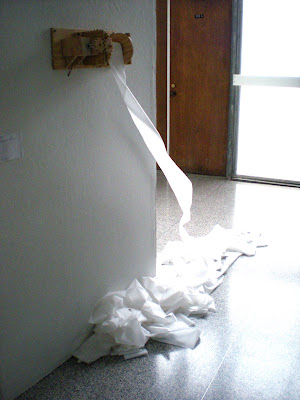Robert Gober, "Untitled"
Mon/Tues class: Due Tuesday, November 23rd
Thurs/Fri class: Due Friday, November 19th For this assignment you will be expected to “mutate” an existing object or group of objects in three distinct phases. The mold making and casting techniques taught in this class should be used in at least one of those steps. You are strongly encouraged to begin working on this assignment without having planned or predicted your final result. Think of each phase as a separate experiment, and let the results from the previous stage determine your next course of action. Work progressively and intuitively.
These projects should be installed in the sculpture gallery, cell space or sculpture “box” by the afternoon of their due date for a group critique. You must decide if your final object is a table-top, floor-standing or wall-mounted sculpture, and display it accordingly. The use of a white pedestal is forbidden for this assignment.
These projects should be installed in the sculpture gallery, cell space or sculpture “box” by the afternoon of their due date for a group critique. You must decide if your final object is a table-top, floor-standing or wall-mounted sculpture, and display it accordingly. The use of a white pedestal is forbidden for this assignment.
The intent of this assignment is to teach you some very basic information about plaster and silicon mold-making, as well as life-casting with plaster gauze. Your goal should be to learn how to properly make a two-part plaster mold and avoid undercuts, and to familiarize yourself with the many different materials that can be used for casting, such as plaster, wax, soap, sugar, and anything else that can change from soft to hard (cake batter?).
The focus of this project is on both the craft and content of your final object, and the way in which it is displayed. Pay attention to the details!
You will be supplied with mold clay, plaster, silicon, wax and plaster gauze. You will be required to supply any other materials you think are necessary for your individual project.
Suggestions and things to consider:
First: choose an object (or small group of objects) that you’d like to “mutate”.
Second: Choose to either make a mold and cast that object in a new material, or to mutate it in some way. Suggested mutation techniques: wrapping, carving, bending, deconstructing, combining, stacking, dissecting, smashing, disfiguring, sanding or wearing away, melting, etc.
Third: If you made a mold as your second step, now is the time to mutate, or vice versa.
Fourth: Repeat step two.
Fifth: Now decide how you will display this object (or group of objects). Consider its scale. Should it be on the floor, hanging on a wall (or sitting on a shelf on the wall), or resting on another object such as a table?
(Note: mold making and casting are one phase. They will not be considered two separate phases!)
This project is due in three weeks! One phase must be completed each week!
The focus of this project is on both the craft and content of your final object, and the way in which it is displayed. Pay attention to the details!
You will be supplied with mold clay, plaster, silicon, wax and plaster gauze. You will be required to supply any other materials you think are necessary for your individual project.
Suggestions and things to consider:
First: choose an object (or small group of objects) that you’d like to “mutate”.
Second: Choose to either make a mold and cast that object in a new material, or to mutate it in some way. Suggested mutation techniques: wrapping, carving, bending, deconstructing, combining, stacking, dissecting, smashing, disfiguring, sanding or wearing away, melting, etc.
Third: If you made a mold as your second step, now is the time to mutate, or vice versa.
Fourth: Repeat step two.
Fifth: Now decide how you will display this object (or group of objects). Consider its scale. Should it be on the floor, hanging on a wall (or sitting on a shelf on the wall), or resting on another object such as a table?
(Note: mold making and casting are one phase. They will not be considered two separate phases!)
This project is due in three weeks! One phase must be completed each week!

















































